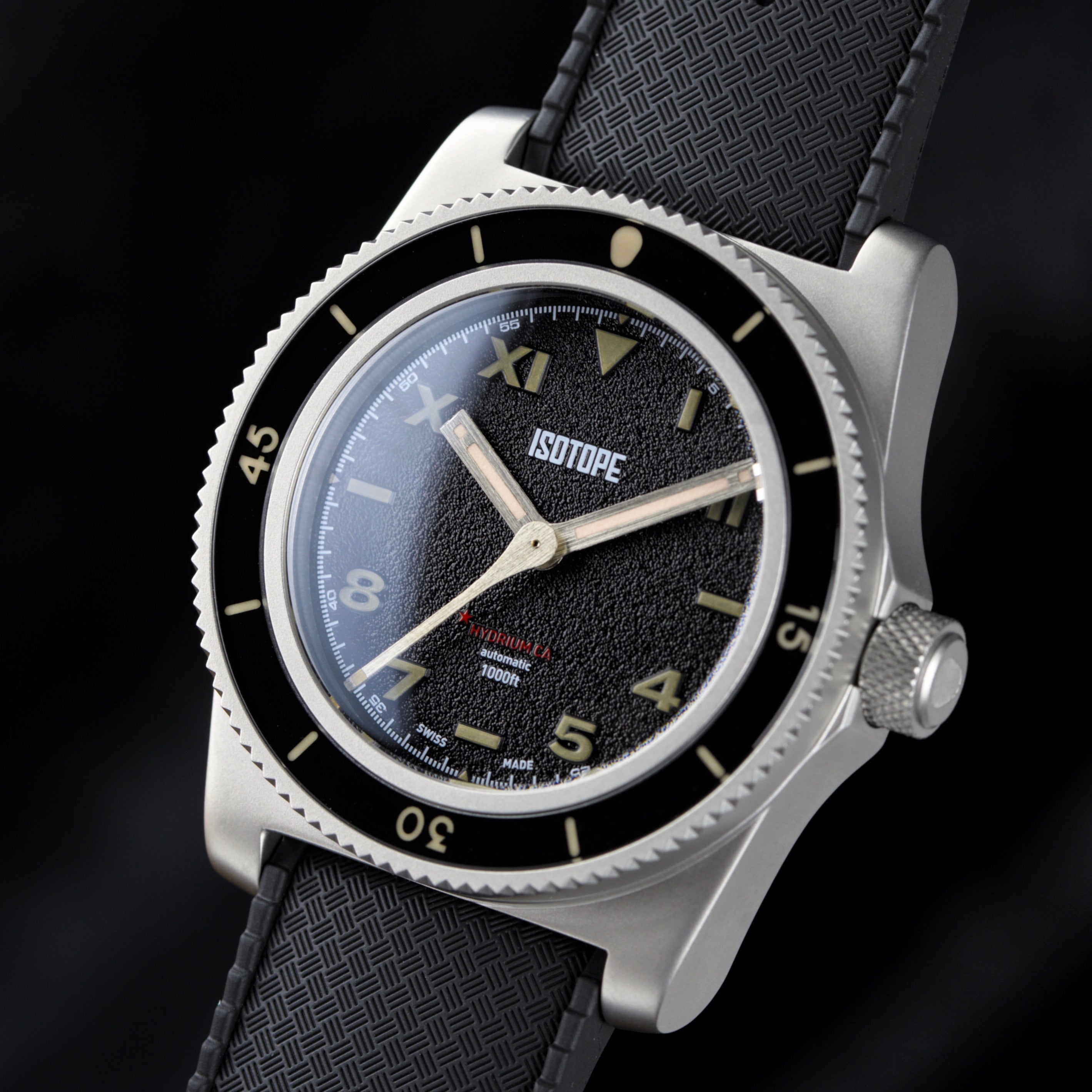
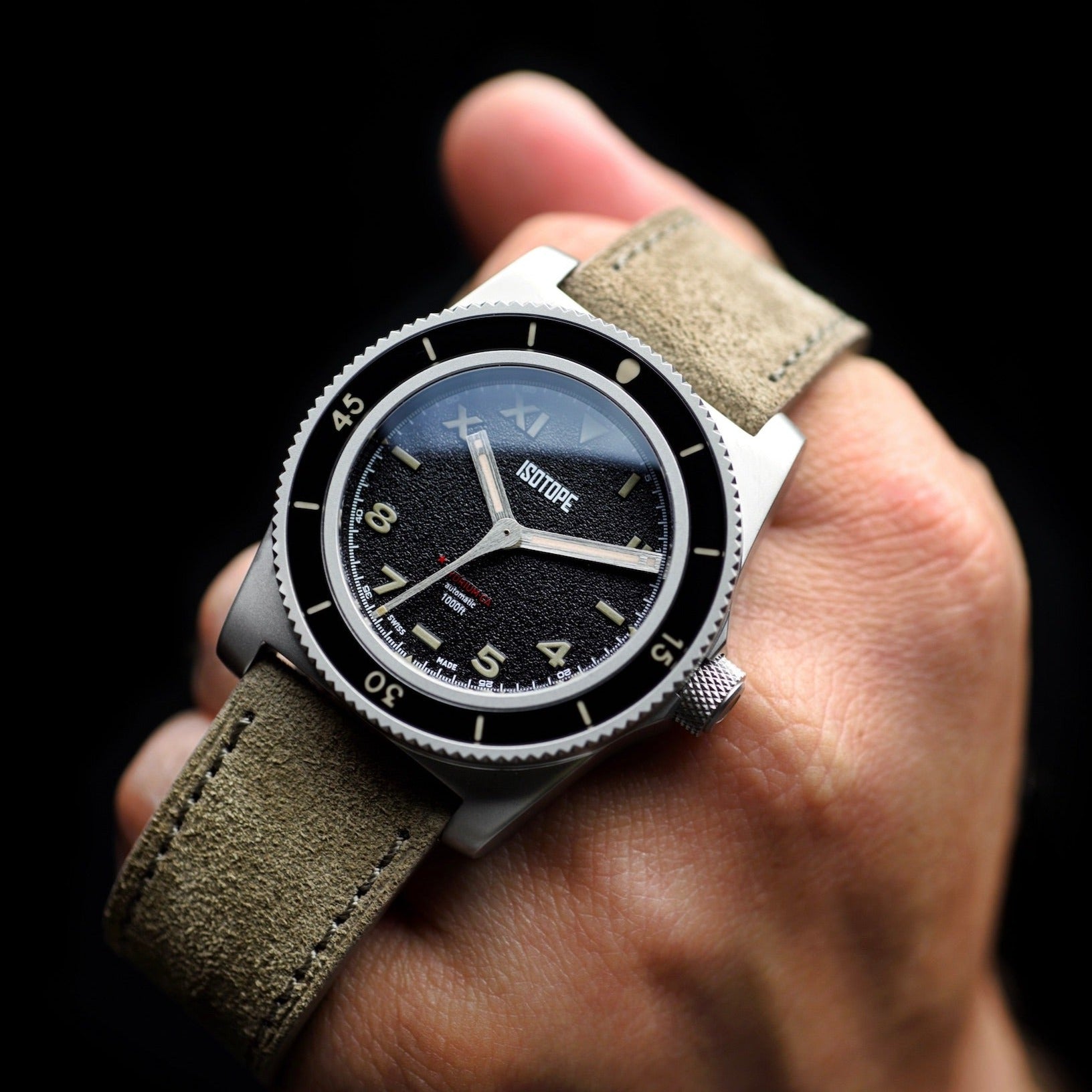

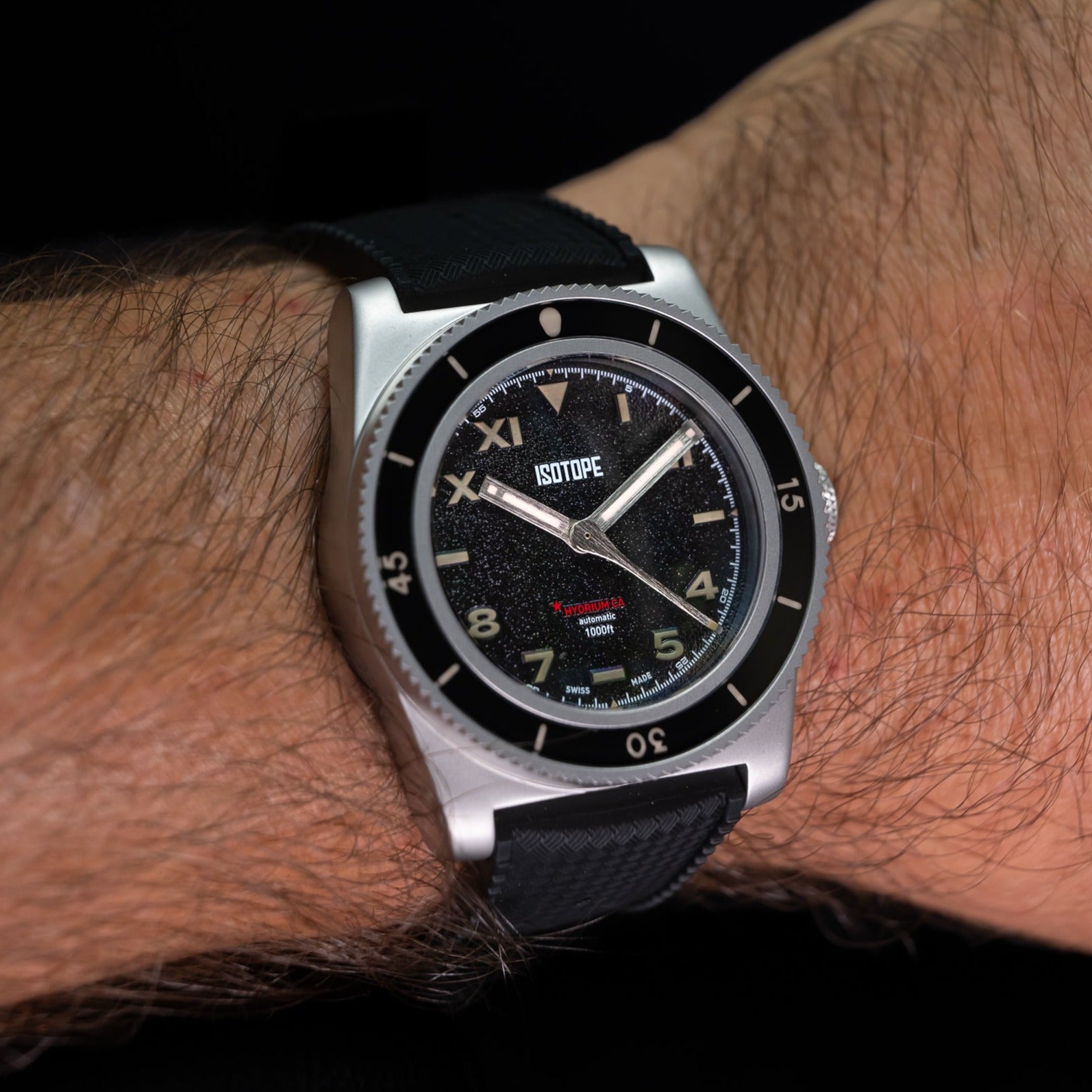
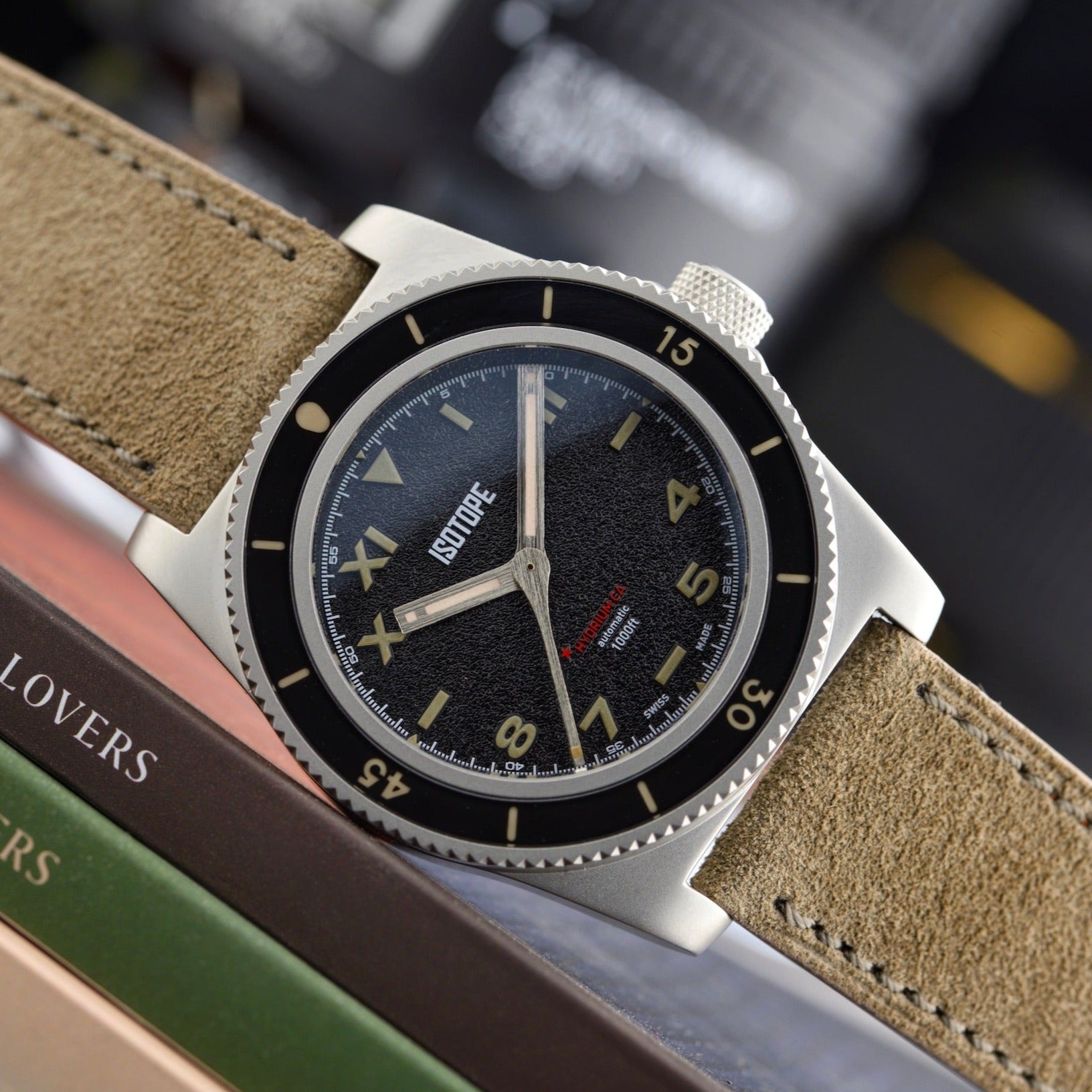
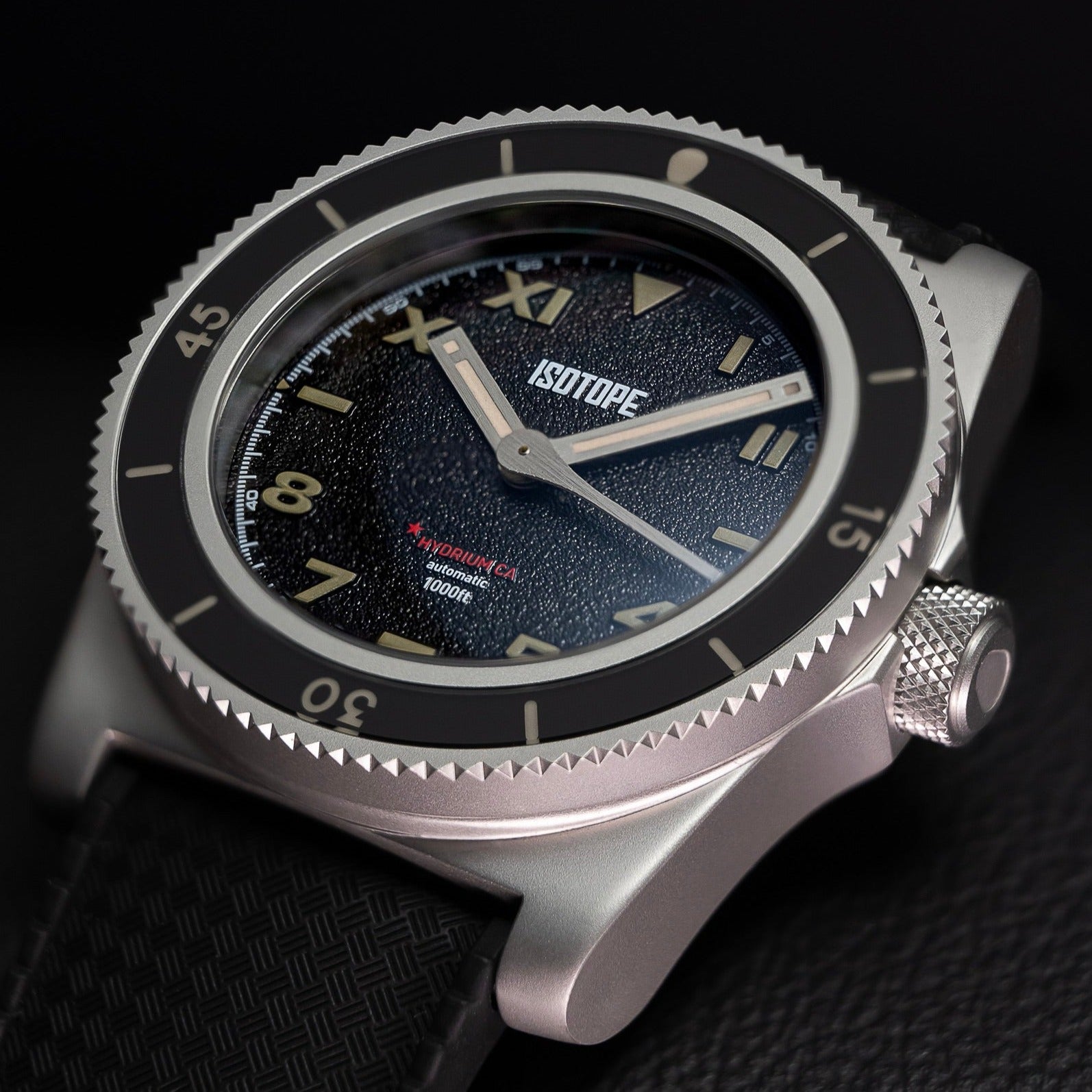
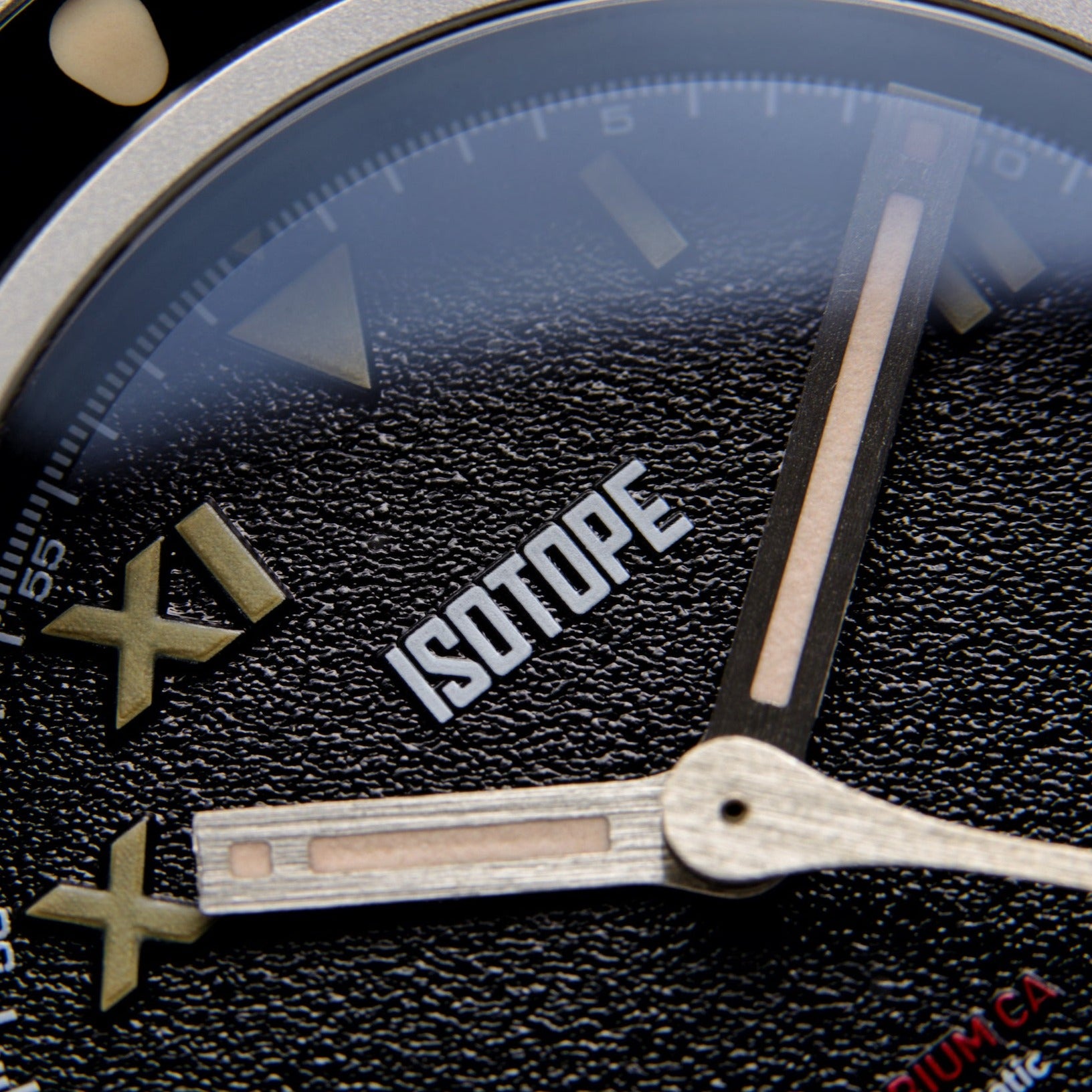
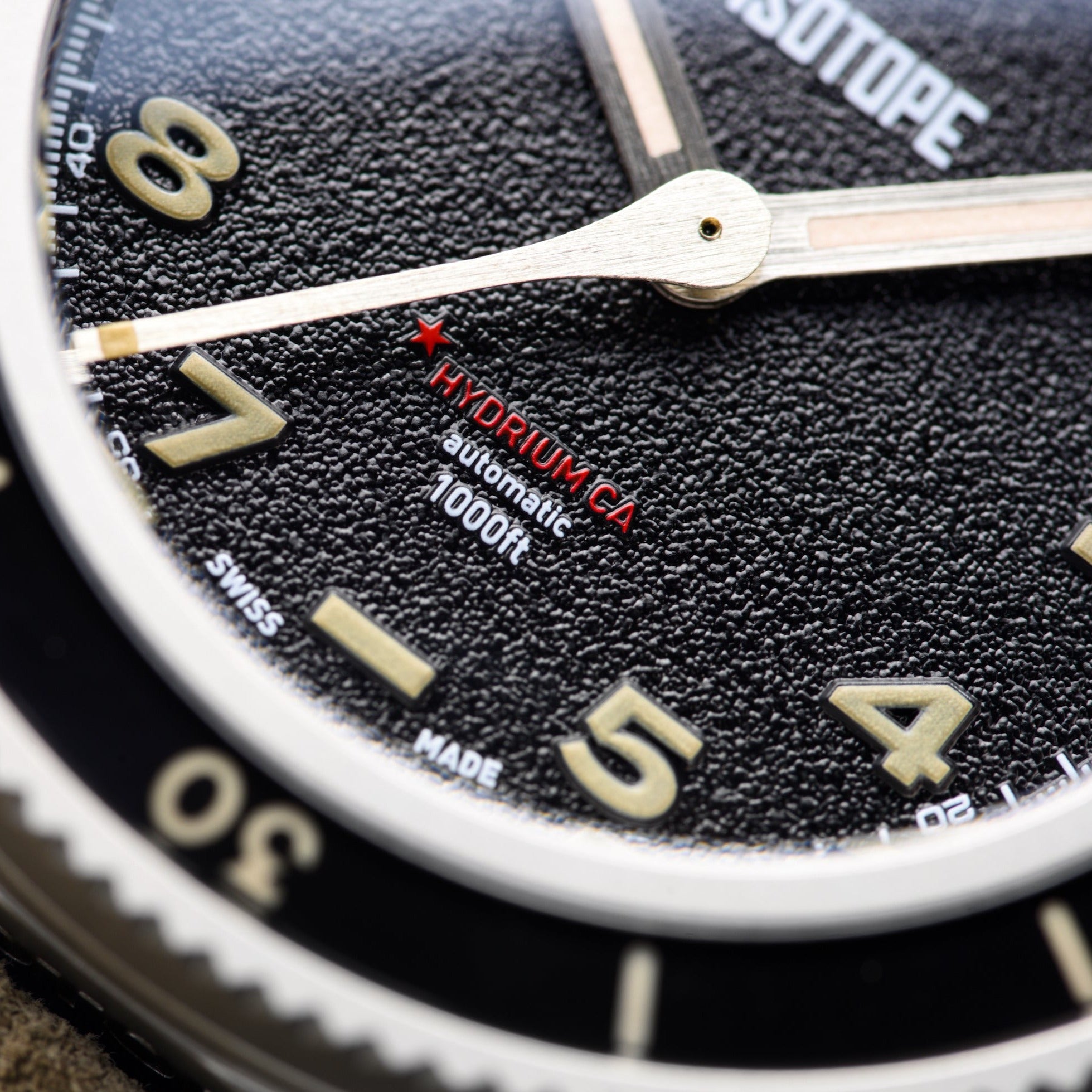
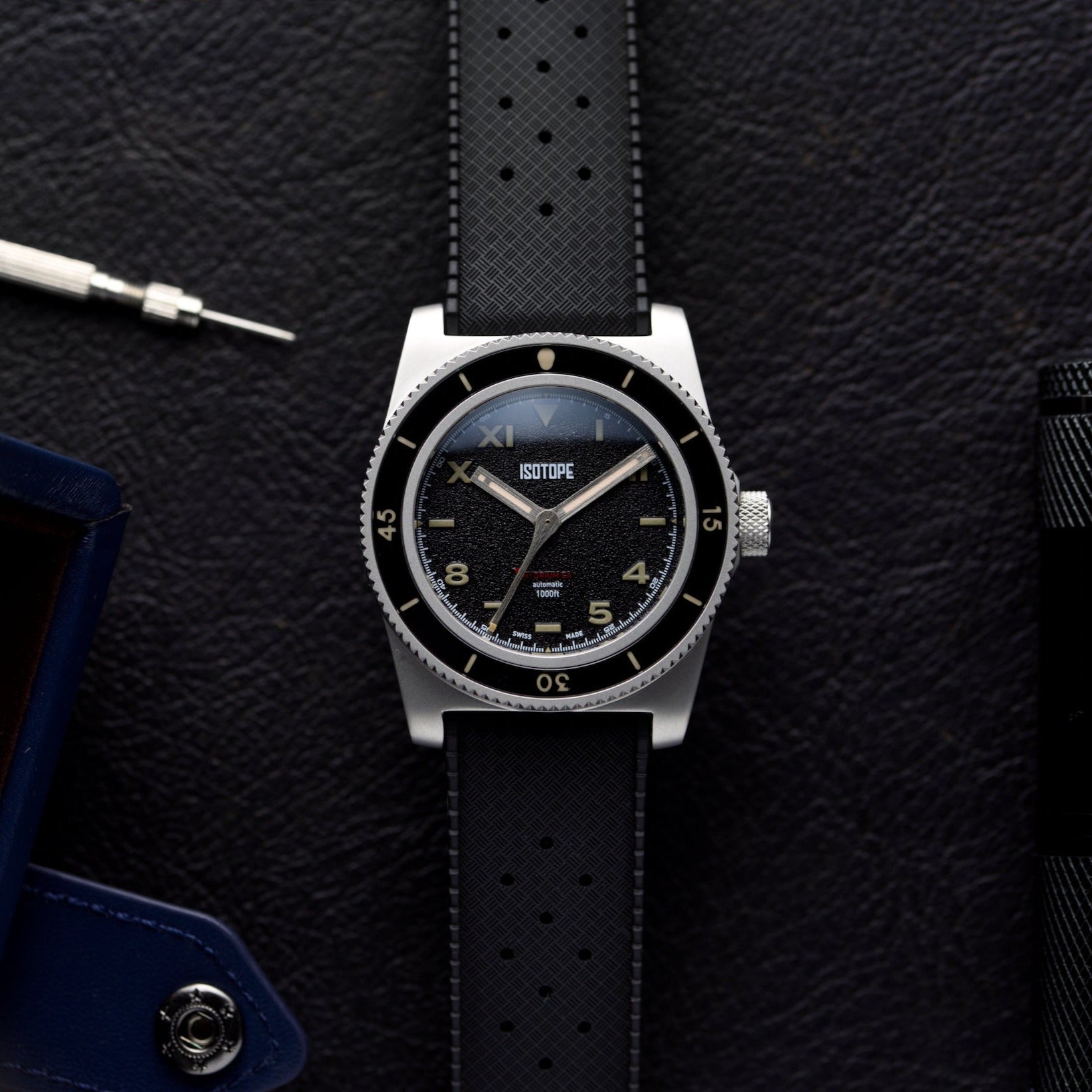
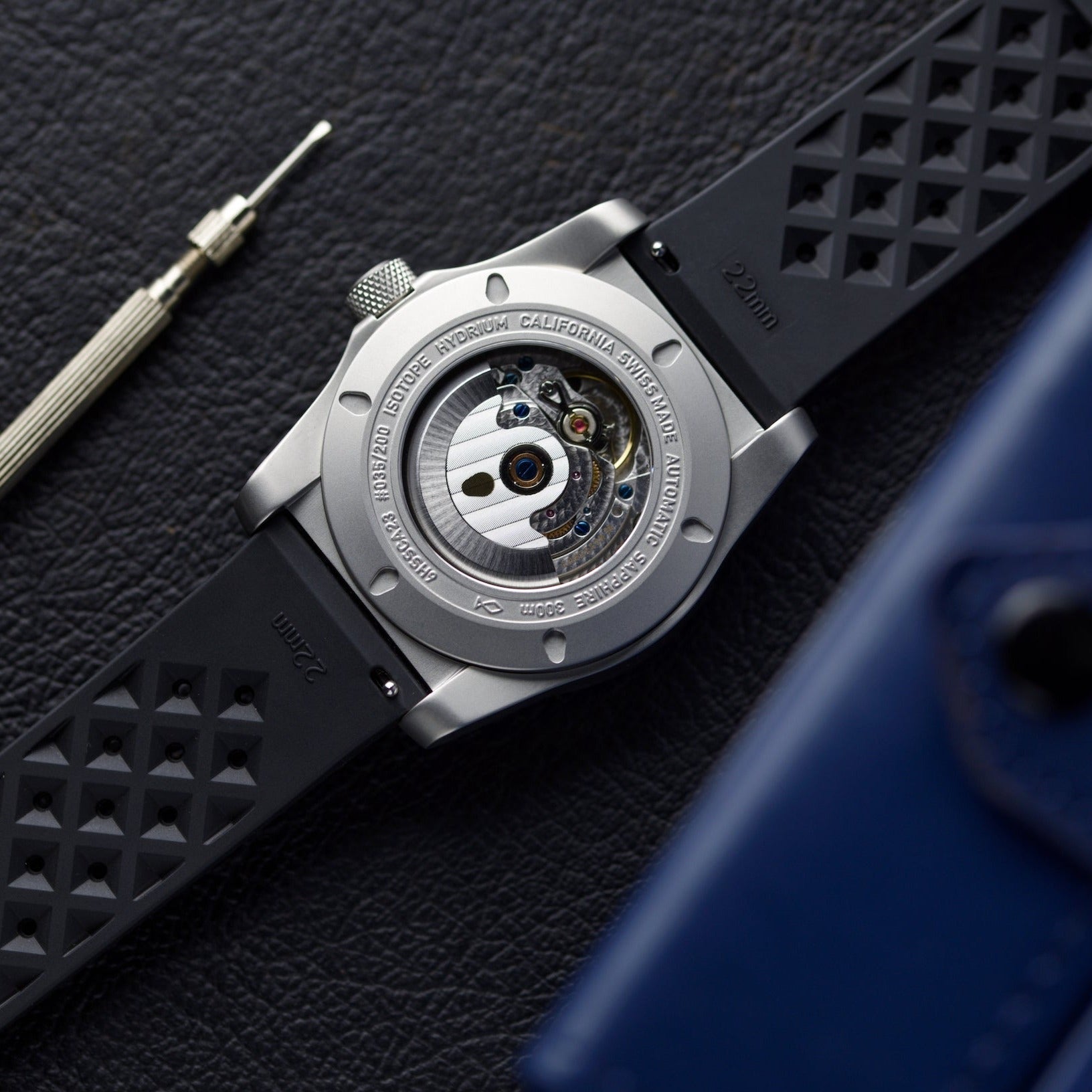


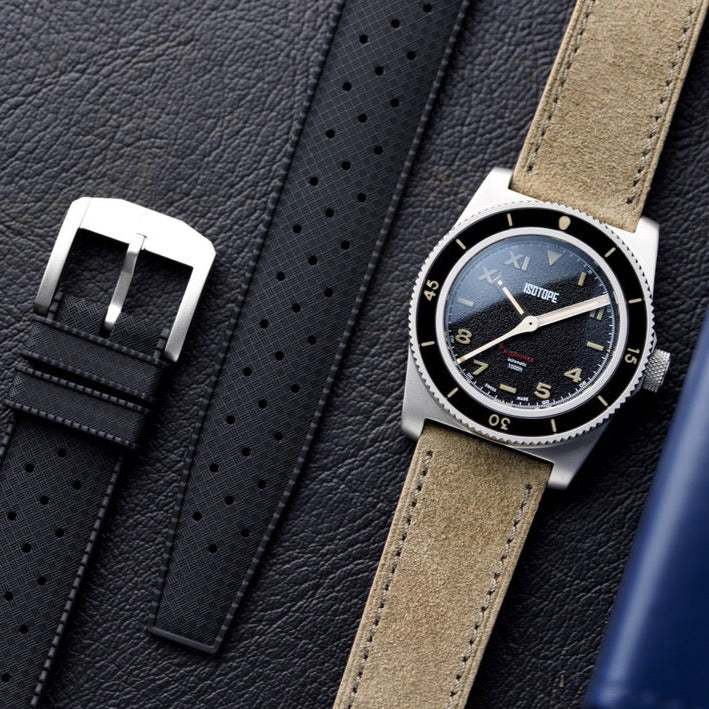

Hydrium California
Tax included only within the UK
Limited edition Isotope Hydrium California
Now with the La Joux-Perret G101 movement
Diving was profoundly different a century ago. What is now the territory of many enthusiastic amateur divers was a field for hardened and determined professionals back then. It wasn't until the documentary 'The Silent World' debuted in 1956 that the general public became more aware of the wonders below sea level. With his ship 'Calypso,' for over two years, underwater pioneer Jacques-Yves Cousteau sailed the Red Sea, Mediterranean Sea, Persian Gulf, and the Indian Ocean, shooting over 25 kilometres of film underwater. Rapid equipment improvements in the following years made the beauty of underwater life more accessible for amateurs to explore, turning diving into a sport.
But in the early days of diving, it was a hazardous endeavour, very much like exploring a different planet. Today, a diving watch is a backup for the diving computer, but in those days, it was a vital piece of equipment. Before the 1950s, dive watches were fairly uncommon for most people because there was no market for them. The majority of professional divers, apart from a few scientists and explorers, were in military units. Their watches were made by government order. As legibility was important, brands played with luminous material to make the dials read as easily. As even the slightest error can make the difference between life and death, there needs to be no confusion at all about the current time. On July 15, 1942, Rolex was awarded a patent (Brevet No.221643, now expired) for a dial with Roman numerals at the top half of the dial and Arabic ones at the bottom. They advertised them as 'error-proof' dials, as there is even a more distinct difference between them. Panerai would also start using these types of dials for their watches, supplied by Rolex and made by Stern Frères around 1944, although they claimed to have already had a prototype with this type of dial in 1936.
As you can see, the 'California dial' history is like murky water with (too) many myths. This is also regarding the name, which this type of dial didn't get until the 1980s. With the renaissance of mechanical watchmaking getting into swing, there was an increased interest in vintage diving watches, among the rarest, those made by Panerai and Rolex, with these dials combining two types of numerals. One of the stories about how the 'California dial' got its name is that vintage watch dealers played into the frenzy by having the dials of original Rolex Bubble Backs refinished. A man by the name of Kirk Rich was their go-to guy, and as he was based in California, the name kind of stuck with experts who used it to indicate these refinished dials. Among the general public, it quickly became the legitimate designation for all dials featuring this unique combination of numerals.
At Isotope, the love for dive watches runs deep. With the Hydrium and HydriumX, a modern dive watch with a nod to vintage design was born. However, Jose Miranda, founder of Isotope, has always dreamed of owning one of the original dive watches with a 'California dial.' With more fakes than real ones floating around in the market, often changing hands for steep prices, they are out of reach to him and many other watch collectors who share his love for this quirky dial design. So he followed his passion and created the 'California dial' he craved so much for the Isotope Hydrium.
It became a watch that, if it existed back then, could very well be used by Jacques-Yves Cousteau and his team when filming 'The Silent World.' The grainy black dial creates a matte effect in which the Arabic and Roman numerals stand out. Filled in with Super-LumiNova, they light up in the dark with their mysterious glow, similar to the luminescent creatures of the sea. The clear white letters of the Isotope logo further indicate that we are dealing with a proper tool watch. The industrial finish of the bold hands, a design that has become a hallmark of Isotope's divers' watches, makes for a visual connection with the case and bezel but also shows an incredible play of light. The 316L stainless steel case is meticulously bead-blasted to ensure that there is no reflection catching the unwanted attention of predators. This might also be a fellow watch collector who lucked out in getting one of the 200 pieces Isotope will make of the Hydrium California. In a nod to the legitimised nickname of this type of dial, the Hydrium name is in red, accompanied by the star of the flag of the State of California, whose abbreviation is also added behind the model name.
For this model, Isotope redesigned its diving bezel to have a bit more of a vintage vibe. It is now divided into five-minute segments with no indications in between for a cleaner look. Zero or sixty, whatever you prefer, is marked with the Lacrima, Isotope's logo, and like the rest of the markings on the bezel, luminous. The 120-click bezel surrounds a double-domed sapphire crystal that protects the dial and hands and further feeds into the vintage character of the Hydrium California.
As it is unwise to change a winning team, the case of the Hydrium California is identical to that of its siblings in the collection. Short lugs not only give this diver's watch a profile unlike any other, but they also ensure that the 40mm large case sits snugly on the wrist. The screw-down crown is fadely nested between the crown guards that emerge organically from the case. Decorated with the Lacrima symbol, it plays its part in ensuring that the Hydrium California is water resistant up to 300m / 30 atm / 1000 ft. The slots to screw down the exhibition caseback also have the shape of Isotope's logo. Beneath the surface lies the beating heart of this diver’s watch: a Swiss-made La Joux-Perret automatic movement with a 68-hour power reserve and a high frequency of 28,800 VpH. Like a coral reef, every component reveals its own beauty, featuring a Soigné finish and a customised oscillating weight adorned with the Isotope Lacrima.
To ensure that the Hydrium California stays securely in place during each dive, the watch is equipped with a 22mm wide FKM strap. These comfortable straps have become a signature feature of Isotope's dive watches, and for good reason – they seamlessly combine attractive aesthetics with exceptional comfort while wearing. The texture of the strap also serves as a visual homage to the earliest straps used on diving watches. Additionally, the Hydrium California can be paired with the new bespoke High-Quality Suede strap, perfectly complementing the vintage yellow aesthetic of the dial and bezel. Complete with a micro-blasted stainless steel buckle adorned with the Isotope logo, it serves as the ideal companion for a watch designed for some California Dreamin’!
Technical Specifications
- Micro-blasted case, 316L stainless steel
- Case diameter 40mm X 48mm (with lugs)
- Height 12.9mm (14.9mm with double domed Sapphire Crystal)
- Hydrium® screw-down exhibition case back
- Unidirectional bezel with 120 clicks
- Anti-reflective crystal sapphire
- Screw-down crown at 3 o’clock
- Black textured dial, Roman and Arabic numbers filled with Super-LumiNova®
- Isotope "i" steel brushed hands filled with Super-LumiNova®
- Water-resistance 300m / 30 atm / 1000 ft
- 22mm Quick-release Black FKM strap or/and High-Quality bespoke Tan Suede strap (limited availability)
Swiss Made La Joux Perret G101 Soigné Movement
- Automatic, self-winding
- Power reserve 68 hours
- 24 Jewels, 28800A/h
- Accuracy: Tested in 4 positions, averaging ±7 seconds/day
- Soigné finish with a custom Isotope Lacrima rotor
CUSTOMS & IMPORT TAX
Ordering from and outside the U.K.
If you’re not based in the U.K. you'll probably need to pay import tax/duty when buying a watch (or any product) from Isotope Watches and other U.K.-based brands
Brexit changed the rules and since the 1st of January 2021, this also includes all countries within the European Community.
Prices within the U.K.
For customers in the U.K., all watches/products are priced including 20% of U.K. VAT.
As an example, if our watch is priced at £1,000, U.K. customers will need to pay £1,200 (£1,000 + £200 (20% VAT)
Prices outside the U.K.
For customers based outside the U.K., all watches/products are priced excluding U.K. VAT.
Your IP address will determine the prices you see on our website, but if for any reason you see prices including U.K. VAT, the prices will be updated at checkout, depending on your shipping address.
Isotope Watches Limited will not charge VAT when exporting, but you will certainly be asked to pay import duty and/or tax/VAT by your customs country.
How to pay for import duty/tax
We ship most of our products/watches via DHL Express. As per customs request, DHL will calculate the duty and taxes and they will collect the payment on behalf of your country's customs.
Neither Isotope Watches Limited nor DHL has control or profit over these costs/taxes.
How much do I need to pay in duty/tax to receive my watch?
It depends on the country you are based in.
Please see the examples below based on a £1,000 watch. These values are only a reference as they vary depending on the watch cost, and they might not be updated.
Within the U.K.
20% tax (GBP 200), is included in the price.
0% duty (GBP 0.00) + 0% DHL's handling fee
European Comunity Countries
Approx. 15%-24% tax (GBP 150 – GBP 240)
0% duty (GBP 0.00) + DHL's handling fee
USA
10% tax (GBP 100)
0% duty (GBP 0.00) + DHL's handling fee
Japan
5% tax (GBP 100)
0% duty (GBP 0) + DHL's handling fee
Canada
5% tax (GBP 50)
8% duty (GBP 80) + DHL's handling fee
China
13% Tax (GBP 130)
20% Duty (GBP 200) + DHL's handling fee
Australia
10% tax (GBP 100)
5% duty (GBP 50) + DHL's handling fee
South Africa
15% Tax (GBP 150)
0% Duty (GBP 0) + DHL's handling fee
United Arab Emirates
5% tax (GBP 50)
5% duty (GBP 50) + DHL's handling fee
If you have any questions, please don't hesitate to email us: info@isotopewatches.com
Choose options














